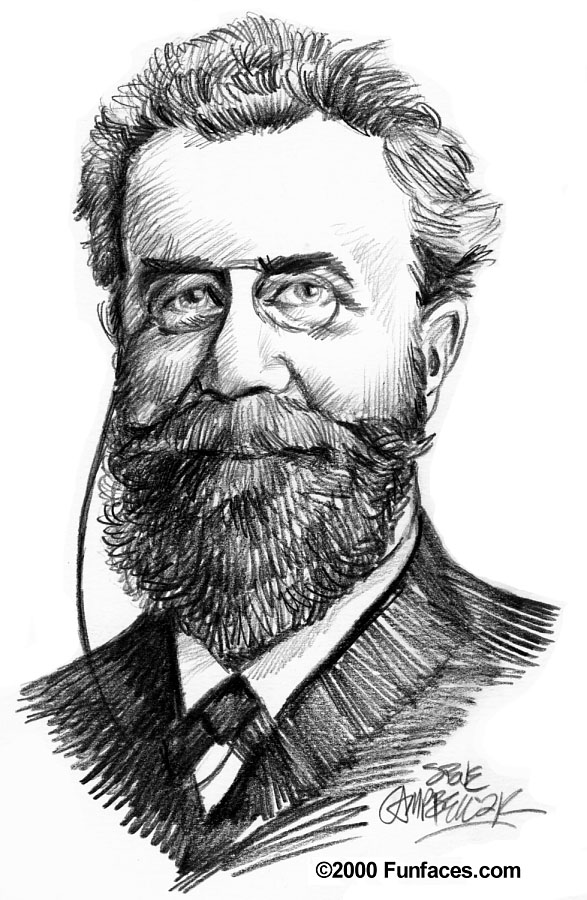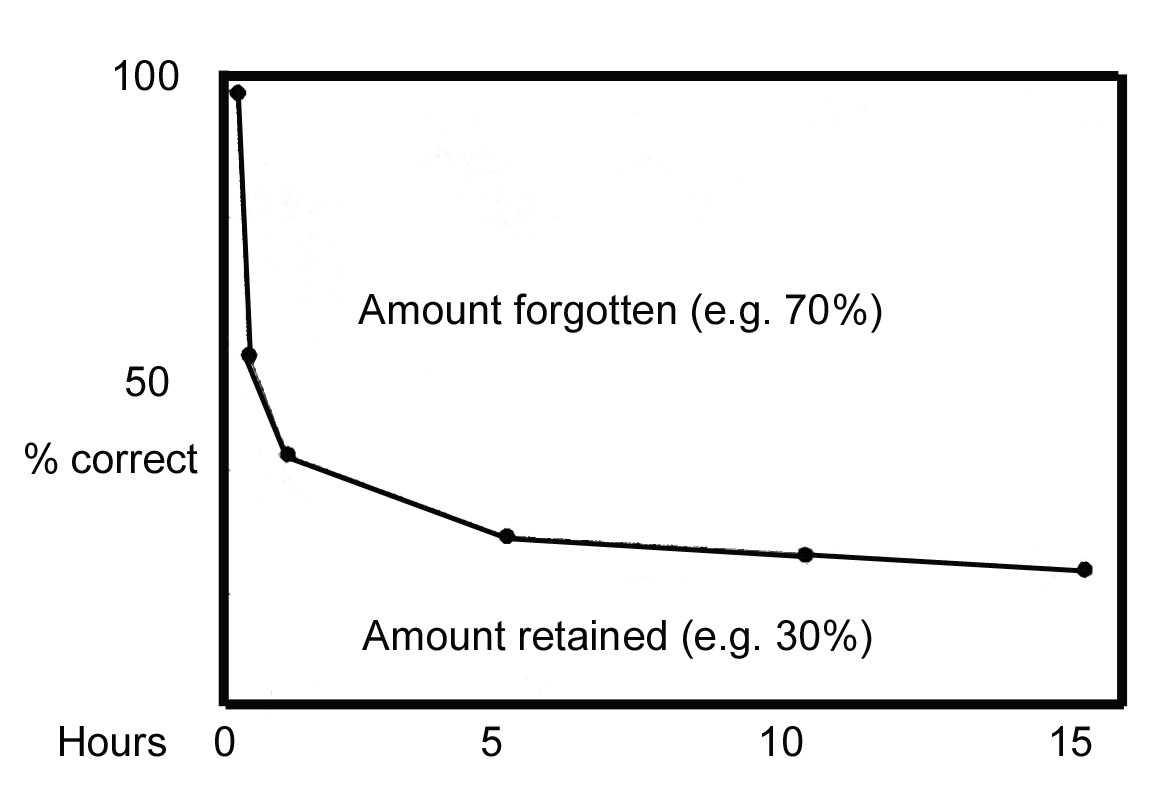Copyright © 2007-2018 Russ Dewey
From Ebbinghaus to Encoding
The first 80 years of research on memory saw changing assumptions about the nature of memory. The earliest researchers assumed memory was a process of receiving experiences and storing them away to be recalled later. Gradually the picture grew more complicated.
By the 1960s, researchers were documenting complex encoding processes that transformed information as it was taken into memory. In this section of the chapter, we will start with early memory research and trace the evolution of assumptions into the computer era.
The scientific study of memory started with the work of Hermann Ebbinghaus, published in 1885 in the book Memory: A Contribution to Experimental Psychology. Ebbinghaus was a careful, cautious researcher who followed simple but logical procedures.
Ebbinghaus had one experimental subject: himself. He presented himself with items to memorize, waited for a precise amount of time, and then tested himself to see how much he remembered.

Hermann Ebbinghaus
Ebbinghaus used nonsense syllables. These were letter combinations like RIY and TPR that Ebbinghaus intended to be meaningless. He gave up on the idea of studying memory for prose (ordinary writing) and poetry, because he had too many associations to the material, and that affected memory. As Ebbinghaus put it:
These materials [poetry and prose] bring into play a multiplicity of influences that change without regularity and are therefore disturbing. Such are associations which dart here and there, different degrees of interest, lines of verse recalled because of their striking beauty, and the like. All this is avoided with our syllables. (Ebbinghaus 1885/1913, p.23)
Why did Ebbinghaus use nonsense syllables?
Nonsense syllables were stimuli Ebbinghaus had never seen before. He wanted to study memory for things being learned for the first time, so nonsense syllables seemed to meet his needs.
As it turns out, nonsense syllables are not treated as "nonsense" by most people who try to memorize them. Subjects easily relate nonsense syllables to actual or made-up words. That realization came years after Ebbinghaus published his research.
What are different types of trigrams?
Nonsense syllables are non-word letter combinations. A nonsense syllable composed of three consonants is a CCC trigram.
A nonsense syllable with a consonant, vowel, and consonant is a CVC trigram. A two-letter nonsense syllable is a bigram; a four-letter syllable is a quadragram.
| CCC trigrams | CVC trigrams |
| CYB WSP LXK TPR SSS DRW | RIY SEH XOP QUZ PUY NIQ |
Ebbinghaus memorized over 2,000 nonsense syllables in the course of his work. He called each presentation of nonsense syllables a trial.
Ebbinghaus gave himself repeated trials until he learned the material to a criterion level of memorization. In his case, the criterion was two perfect (error-free) recalls of the list.
Who was Ebbinghaus's main subject? What is a "trial" in memory research?
A criterion is a goal that must be met, for memorization to be considered complete. Ebbinghaus used the criterion of two perfect recalls of a list.
Ebbinghaus figured his memory of a list was not very stable if he could not reproduce the list correctly twice in a row. Two perfect recalls seemed like a reasonable criterion of memorization.
You do not need a criterion of learning in every experiment. If you want to find out how much a person gets out of one exposure to a list of words, you could just present a list once and test a person the next day.
But if you are interested in studying how long a memory lasts, you must be sure the memory is fully formed. A criterion of memorization or criterion of learning defines the point at which material is considered to be really memorized.
When is a criterion of learning or memorization needed?
After reaching his criterion of learning, Ebbinghaus waited for a length of time called the retention interval. During this time, the information had to be held (retained) in memory.
The retention interval is defined as the time from the last presentation of the material (the end of the last trial) until the test. Ebbinghaus experimented with retention intervals ranging from several minutes to several days.
What is a retention interval?
Finally, after the retention interval, memory has to be tested or measured in some way. Ebbinghaus tested his memory by relearning the same list.
Naturally, he required fewer trials to learn the list a second time. Ebbinghaus measured the strength of memory by the savings that occurred between the first and second learning periods.
It might take 10 trials to learn a list to the criterion of two perfect recalls the first time. If it only took 5 trials the second time, he called this 50% savings.
What measurement technique did Ebbinghaus use?
The savings measure is not used very much in today's memory research. However, it represents a powerful way of measuring memory called relearning.
Relearning can show the effects of experience after other types of memory vanish. For example, a student exposed to a foreign language as a child may learn the language quickly in a college course. Even if little conscious memory of the original learning remains, it is revealed as "savings" or unusually rapid learning the second time around.
In what sense is relearning a powerful measure of memory?
The Forgetting Curve
Ebbinghaus discovered that the greatest amount of forgetting occurred soon after learning a list. After a rapid initial drop-off, the memory slowly weakened with time. The curve Ebbinghaus discovered is called the forgetting curve.

The forgetting curve
When does the most forgetting take place in the least amount of time?
Today's researchers usually express results of a memory test as a percentage of items retained. If you remember 4 of 10 items, you have 40% retention. Forgetting is the opposite of retention. If you have 40% retention, you have 60% forgetting.
Other researchers, using similar laboratory tasks, confirmed the basic shape of the forgetting curve discovered by Ebbinghaus. However, personal event memories (memories for single events in life) may follow a different forgetting curve.
Marigold Linton (1979) wrote down two memorable events every day for six years, then systematically tested her recall of these events. She found that she lost the ability to retrieve 5-6% of the items per year.
She did not find the same curve as Ebbinghaus. Her data fell on a straight line. This illustrates how sometimes a pattern that occurs in laboratory settings may not appear in more naturalistic situations.
What did Linton study? How did her results differ from the classic forgetting curve?
---------------------
References:
Ebbinghaus, H. (1885/1913). Memory: A Contribution to Experimental Psychology. (Transl: H. A. Ruger & C. E. Bussenius.) New York: Teachers College.
Linton, M. (1982). Transformations of memory in everyday life. In U. Neisser (Ed.) Memory Observed: Remembering in Natural Contexts. San Francisco: Freeman.
Write to Dr. Dewey at psywww@gmail.com.
Don't see what you need? Psych Web has over 1,000 pages, so it may be elsewhere on the site. Do a site-specific Google search using the box below.
